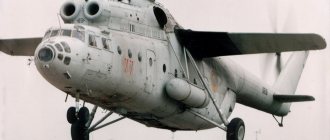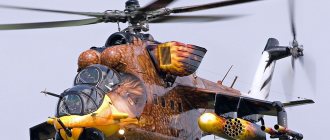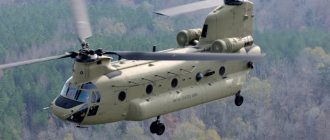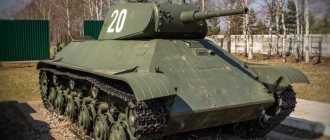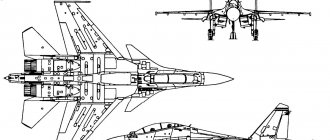| Mi-26 | |
| Type: | Transport and landing helicopter |
| Developer: | OKB M. L. Mil. |
| Manufacturer: | Rostvertol |
| First flight: | December 14, 1977 |
| Status: | In production, in use |
| Main operators: | Russian Air Force, USSR Air Force (former), Kazakhstan Air Force, Ukrainian Air Force, Belarusian Air Force |
| Years of production: | Since 1980 |
| Units produced: | 310 |
| Unit cost: | $20-25 million (2011) |
Mi-26 (product “90”, according to NATO codification: Halo ) is a Soviet/Russian multi-purpose transport helicopter. It is the world's largest serial transport helicopter.
History of creation and production
The Mi-26 heavy transport helicopter was developed by the Moscow Helicopter Plant named after. M.L. Mil (general designer M.N. Tishchenko, chief designer G.P. Smirnov, leading designer O.P. Bakhov) and was intended to replace the Mi-6 and Mi-10 helicopters.
The preliminary design was approved in December 1971, and the following year positive conclusions were received from relevant institutes and the Ministry of Defense. In 1972, a prototype of the Mi-26 was built, which was accepted by the State Commission in 1975. By that time, most of the design work had been completed, and V.V. became the new leading designer. Shutov.
The first flight prototype of the Mi-26 left the assembly shop (Panki) in October 1977, and on December 14 of the same year it took off under the control of a crew led by leading test pilot G.R. Karapetyan. In February 1978, the helicopter flew to the flight test base in Lyubertsy, where its factory tests began. Joint State tests of two Mi-26s took place at the Air Force Research Institute from May 1979 to August 1980. During the tests, both helicopters performed 150 flights with a total duration of 104 hours. As a result, recommendations were received for launching the Mi-26 into mass production and accepting it into service with the Soviet Army.
Serial production of the Mi-26 was organized at the Rostov Helicopter), the D-136 engine at the Zaporozhye Production Association "Motorostroitel" (today JSC "Motor Sich", chief designer F.M. Muravchenko).
Adopted by the Air Force in 1985, 276 vehicles were produced until 1997.
In October 1980, testing of the first Mi-26 (No. 01-01) began. Serial production of Mi-26 helicopters began in 1984; in total, more than 300 helicopters for civil and military purposes were built. The first series consisted of three (No. 01-01 - 01-03), the second - five (No. 02-01 - 02-05) cars. Further production took place in series of ten cars. One helicopter (No. 04 -10A) was transferred to TsAGI in 1985 for static tests. 40 helicopters were exported to various countries (including 12 to Canada and 10 to India).
"Sikorsky CH-53E"
This modification is a heavy transport aircraft, which is considered the largest rotorcraft built in America. Its original purpose is to carry out special operations in Marine Corps units. However, later the Sikorsky CH-53E cargo helicopter began to be used in other areas. During its operation it proved itself to be a reliable, fast and effective device.
The unit is in service with several countries, including Germany, the USA, Mexico and Israel. In total, more than 520 cars of this series were produced. The maximum take-off weight is 19 tons, the maximum speed is 315 kilometers per hour, and the empty weight is 10.7 tons.
Design features
The helicopter is built according to a single-rotor design with a tail rotor and a three-post wheeled landing gear that is not retractable in flight.
Fuselage
fuselage is made of aluminum-lithium alloys with extensive use of titanium alloys and composite materials. In the bow there is a crew cabin, consisting of the first pilot in the front left seat and the second pilot in the right seat. Behind the first pilot is a flight engineer, and behind the second is a navigator-radio operator; between the pilots, a cargo operator can be located on a folding seat; behind the cockpit there is a separate cabin for four passengers.
The cargo compartment is located in the central part of the fuselage. It is equipped with mechanized loading and unloading means, consisting of two hoists with a lifting capacity of 2500 kg and an electric winch with a force of 500 kg for moving cargo along the cabin floor, which is equipped with roller tables and hooks for securing cargo. The cabin is equipped with a cargo hatch with a lowering cargo ramp with doors opening outward.
The tail boom, with a flat bottom surface to improve loading and unloading conditions, transitions into a large vertical tail with an asymmetrical profile to create lateral force and unload the tail rotor and an adjustable stabilizer when parked.
The main rotor is eight-bladed, with hinged blades and hydraulic dampers. The rectangular blades have improved aerodynamic profiles with a relative thickness of 0.12 at the butt and 0.09 at the tip of the blade and moderate aerodynamic twist. The blades are of mixed construction with a tubular steel spar, to which are attached 26 sections with ribs, fiberglass skin and honeycomb core. The tip of the blade is protected by an anti-corrosion lining made of titanium alloy. The blade chord is 0.835 m, the peripheral speed of the blade tips is 220 m/s.
Tail rotor
The tail rotor is five-blade, 7.67 m in diameter, with rectangular fiberglass blades.
Chassis
gear is non-retractable, tricycle, with twin main wheels and a retractable tail support. The front support is self-orienting, the main supports with twin wheels measuring 1120x450 mm are small in size, and double-chamber shock-absorbing struts provide a change in ground clearance when parked.
Hughes XH-17 cargo helicopter
This device was built back in 1952. At that time it was considered colossally heavy (19.7 tons). This flying crane was used to lift and transport super-heavy loads using an external sling. Only one copy of the unit was produced; its test flight took place in the city of Culver (California). The maximum speed is 145 kilometers per hour. Until now, this machine holds the record for the size of the main rotor, the diameter of which is 36.9 meters.
Power point
power plant consists of two D-136 turboshaft engines with a takeoff power of 11,400 hp each. and an auxiliary power unit (APU) TA-88 (located under the cockpit on the left side and provides engine start and drive of the electrical and hydraulic systems and the air conditioning system when parked).
The D-136 engines are installed side by side on top of the fuselage in separate nacelles separated by a titanium firewall. The engine air intakes are equipped with dust protection devices and electrical anti-icing systems. The power plant has a system for automatically maintaining rotor speed; in the event of failure of one engine, the system automatically increases the power of the second to emergency, maintaining constant rotor speed (132 rpm).
The transmission consists of a main gearbox, two freewheels, tail rotor drive shafts, an intermediate gearbox and a tail rotor gearbox. The main gearbox VR-26 is of a modular design, three-stage, and has drives for the cooling fan of the gearbox and oil systems installed above the air intakes of the engines, tail rotor transmission and helicopter units. Gearbox length 2.5 m, width 1.95 m and height 3.02 m, weight 3640 kg.
For servicing the power plant and transmission, the engine fairings are equipped with large hinged panels used as working platforms, and the tail boom has a passage for servicing the tail rotor transmission without special ground equipment.
The fuel system includes several soft fuel tanks with a total capacity of 12,000 liters.
Equipment
When developing the Mi-26 military cargo helicopter, the designers took into account the shortcomings and problem areas of previous models. The changes mainly affected the air intakes. Dust protection was installed in front of these elements, making it possible to clean the flow by seventy percent. This solution made it possible to take off from dusty areas without reducing engine power.
In addition, repair sites have been transformed, which do not require additional equipment when servicing the machine by mechanics. Convenience of loading and unloading operations is ensured by a pair of winches with a lifting capacity of 5000 kilograms. It is also possible to adjust the loading ramp using a hydraulic drive, which can be controlled from the cockpit, cargo compartment or from the outside of the helicopter. The developers have equipped the aircraft with a number of devices that facilitate loading from vehicles or directly from the ground.
The Mi-26 equipment was produced using the latest technologies and technical achievements. The helicopter is equipped with a weather radar, allowing it to fly regardless of weather conditions and time of day. This device is highly accurate and takes a few minutes to set up. The cockpit also features three-channel autopilot and an upgraded message and flight data recording system.
Equipment
Equipment . The navigation system for flights day and night, in simple and adverse weather conditions, includes a combined heading system "Crest-2", a flight command device PKM-77M and an attitude indicator AGR-83-15, automatic radio compasses ARK-19 and ARK-UD, a radio engineering system short-range navigation "Veer-M", Doppler speed and drift angle meter DISS-32, antenna-feeder system "Romashka", radio altimeter A-036.
The PKV-26-1 aerobatic system includes a four-channel autopilot VUAP-1, a trajectory control system, a director control system, and a load oscillation damping system on an external sling. There is a weather radar.
Radio communications equipment includes VHF command radios R-863 and R-828, HF communications radio station Yadro-1B, emergency radio station R-861 and aircraft intercom SPU-8, on-board television equipment BTU-1B with three video cameras and a video control device VK -175 for monitoring the condition of the cargo on the external sling. A Tester-UZ magnetic flight data recording system and RI-65 voice communication equipment were installed to alert the crew about in-flight emergencies.
Description of design
The helicopter is built using a single-rotor design with an eight-blade main rotor and a five-blade tail rotor. With two engines producing 11,400 hp. each and a three-post fixed landing gear.
The all-metal fuselage of semi-monocoque design has a variable cross-section. In its bow there is a radio-transparent radome covering the radar antenna, a crew cabin, a cabin for passengers accompanying the cargo and compartments for placing equipment. The central part of the fuselage includes a cargo compartment measuring 12.00 × 3.25 × (2.95-3.57) m and a rear compartment that extends into the end beam.
The transport-landing version of the helicopter can accommodate 82 paratroopers with weapons. The ambulance version of the helicopter can accommodate up to 60 stretchers with wounded. For loading large cargo, an electric winch with a traction force of up to 500 kg is located in the cargo compartment. The helicopter is also capable of transporting cargo on an external sling. Load capacity - up to 20 tons of payload. The helicopter can be used for both military and civilian missions, as well as for search and rescue operations.
Today, the Mi-26 is the largest mass-produced transport helicopter in the world (in the USA, the Sikorsky company produces the CH-53E Super Stallion, which is similar in tasks and one and a half times inferior to the Mi-26 in load capacity).
History of the Mi-26
The Mi-26 began to be developed at the Mil Design Bureau in the early 70s of the last century. The new cargo helicopter was supposed to deliver heavy cargo to sparsely populated areas of the Soviet Union. It was created as a replacement for the model created in the same design bureau - the cargo Mi-6. Initially, the Mi-26 helicopter was not planned to be used for military purposes. The new vehicle was needed to deliver cargo weighing 10-15 tons over a distance of 500-800 kilometers.
The designers set themselves the goal of maximizing the use in the new vehicle of proven components and assemblies that were used on the Mi-8, Mi-12 and Mi-6 and were already mass-produced. Several schemes for the future machine were considered: single-screw, double-screw, longitudinal and transverse. Research conducted jointly with specialists from TsAGI and CIAM showed the advantages of the classic single-rotor design. According to the technical specifications developed for the new vehicle, the Mi-26 was supposed to transport cargo weighing up to 20 tons over a distance of at least 400 kilometers. The engines for the new heavy helicopter were developed at Zaporozhye.
The creators of the Mi-26 paid great attention to the design of the main rotor. The new machine was equipped with a propeller with metal-plastic blades with a diameter of 28 meters. This solution significantly improved the technical characteristics of the helicopter, increased its thrust and reduced the overall weight. The fuselage of the new vehicle turned out to be especially successful: while maintaining the required weight of the fuselage, it was possible to increase the rigidity of the structure and increase the useful volume of the cargo compartment several times.
When creating a new heavy helicopter, the operating experience of previous models was taken into account. Dust protection devices were installed in front of the air intakes, which significantly increased engine life. Convenient access to all components and assemblies was thought out, which made the repair and maintenance of the Mi-26 as convenient as possible. The cargo compartment was equipped with loading equipment (electric winch, hoist). The vehicle can transport cargo on an external sling (up to 20 tons).
Initially, the vehicle was designed to transport personnel. The cargo compartment could accommodate 82 paratroopers with weapons or 60 wounded on stretchers. In a few hours, the Mi-26 helicopter could be converted into an ambulance.
Construction of the prototype began in 1972, and the aircraft made its first flight in 1977. In 1980, the Mi-26 successfully passed state tests, receiving high praise from the State Commission and the pilots who conducted them. It was recommended that the new vehicle be put into production and put into service.
In 1983, military tests of the new vehicle began, and in 1985 it began to enter service with the troops.
This car was shown to the general public in 1981, at the international exhibition in Le Bourget. She created a real sensation.
The helicopter was actively used in the Afghan war. It was the Mi-26 that first evacuated the damaged Mi-8 helicopter. Mi-26 helicopters operated in Afghanistan from air bases in neighboring Tajikistan and carried out missions for the Soviet group: transporting cargo and personnel, evacuating the wounded. Already after the start of the multinational coalition invasion of Afghanistan, the Mi-26 carried out the evacuation on an external sling of two damaged CH-47 Chinook helicopters (US Air Force) and an AS-532 Cougar helicopter (Dutch Air Force).
The Mi-26 was actively used during the liquidation of the consequences of the disaster at the Chernobyl nuclear power plant since 1986. This vehicle took part in the conflict in Nagorno-Karabakh, in the first and second Chechen campaigns, and in several conflicts on the African continent.
Several cars were hit. The largest helicopter crash in the history of world aviation is associated with the Mi-26. In 2002, near Khankala, an Mi-26 was shot down by Chechen separatists using Igla MANPADS. 127 people died in this terrible tragedy.
The helicopter is perfect for solving problems of both military and peaceful nature. It can be used for rescue operations and transportation of oversized cargo on an external sling. This helicopter is also used to extinguish forest fires.
Today, these vehicles are in service with several dozen countries. Most of all Mi-26 are in the Russian Air Force. These helicopters are also actively used by the Russian Ministry of Emergency Situations. The machine has several dozen modifications, its production continues at the helicopter plant in Rostov. Until 2011, 316 units were produced, 40 vehicles were sent to other countries.
The Mi-26 is currently the largest mass-produced transport helicopter in the world. It set several world records for payload, altitude and range. The machine has excellent technical characteristics and is loved by pilots and maintenance personnel. Due to their unique characteristics, these helicopters are very popular both in Russia and abroad.
Performance characteristics
The given characteristics correspond to the Mi-26T .
Specifications
- Crew: 5 (2 for Mi-26T2)
- Passenger capacity: 85 soldiers or 70 paratroopers with full equipment or 60 stretchers for the wounded and three seats for accompanying medical personnel
- Load capacity: 20,000 kg
- Length: 40.02 m
- Fuselage length: 33.74 m
- Main rotor diameter: 32.0 m
- Tail rotor diameter: 7.61 m
- Maximum fuselage width:
- Height:
- Rotor swept area: 804.25 m²
- Chassis base:
- Chassis track: 5.0 m
- Empty weight: 28,200 kg
- Normal take-off weight: 49,600 kg
- Maximum take-off weight: 56,000 kg
- Mass of fuel in internal tanks:
- Fuel tank volume: 12,000 l (14,800 l in four tanks or 4,780 l in two tanks)
- Powerplant: 2 × Motor Sich D-136 turboshafts
- Engine power: 2 × 11,400 l. With. (takeoff)
Flight characteristics
- Maximum speed: 295 km/h
- Cruising speed: 265 km/h
- Practical range: 800 km
- Ferry range: 2350 km (with four anti-tank tanks)
- Flight duration: with maximum fuel reserve:
Modifications
- B-29 - prototype
- Mi-26 - military transport version
- Mi-26A - improved version
- Mi-26M - designed for increased performance and equipped with new navigation equipment and a new propeller.
- Mi-26MS - medical version
- Mi-26NEF-M - anti-submarine version
- Mi-26P - civilian version for 63 passengers
- Mi-26PK - “flying crane”
- Mi-26T - civil transport version
- Mi-26T2 is an updated basic model for round-the-clock use with a reduced number of crew members and new avionics. Serial production of the modernized helicopter is planned to begin in 2012.
- Mi-26TC - cargo version
- Mi-26
- Mi-26TP - firefighting version
- Mi-26PP - jammer
- Mi-26TS - export version of the Mi-26T
- Mi-26TZ - tanker
- Mi-27 - air control center
Mi-27
In the mid-1980s. A number of military modifications were developed on the basis of the Mi-26. In accordance with a government decree, an air control center was built at the Rostov Helicopter Plant in 1988, designed to control the combat operations of combined arms armies. The vehicle received the designation Mi-27.
The design of the Mi-27 is similar to the basic helicopter. The cargo compartment was divided by transverse partitions into the operational group (OG) cabin, technical and living compartments. There were 6 workplaces in the exhaust cabin; in the next compartment there was a group for managing technical equipment and organizing communications; additional rest areas could be organized there if necessary. The technical compartment contained radio communication equipment. Household equipment included a water supply system, a buffet, a compartment for resting two people and a toilet.
Two production helicopters were converted and tested in Leningrad and Evpatoria. One of these machines then ended up at the Kharkov Air Force Institute, where it is still used today as a visual aid.
Mi-10 rotorcraft
This is a Soviet transport vehicle that was developed from 1961 to 1964. It belongs to the category of military transporters, designed on the earlier Mi-6 basis. It was put into operation in 1963. The maximum load capacity of the machine is 15 tons. The weight of the empty vehicle is almost twice as high, the maximum speed is 235 kilometers per hour.
The critical take-off weight is 43.7 tons. Its second name is “Flying Crane”. It seats twenty-eight passengers on board and is designed primarily for transporting ballistic projectiles.
Application
- Afghan war
- Elimination of the consequences of the Chernobyl accident
- Civil War in Angola
- Karabakh war
- First Chechen War
- Second Chechen War
The first combat use of the Mi-26 took place in 1984 in Afghanistan as part of the 23rd separate aviation regiment of the Border Troops of the KGB of the USSR, stationed in Dushanbe.
In 1988, the first unique operation was carried out to evacuate a damaged Mi-8 on an external Mi-26 sling from Afghanistan to the territory of the USSR. The operation was carried out by Yuri Ivanovich Stavitsky, now a Hero of Russia. 37
On September 27, 1996, it was used to build a large formation, which was later included in the Guinness Book of Records. During this event, another record was set, the Mi-26 lifted 224 parachutists to a height of 6500 meters.
Used to evacuate 2 CH-47 Chinook helicopters from the US military in Afghanistan, cost $650,000.
Used to recover a damaged Dutch Air Force AS-532 Cougar helicopter in Afghanistan.
Used to transport a Tu-134 aircraft from Pulkovo airport to the Emergencies Ministry training ground near the Rybatskoye microdistrict in St. Petersburg.
V-12 (Mi-12)
The experimental twin-rotor helicopter is the largest machine of its kind in the world. It was assumed that it would transport cargo weighing at least 30 tons, including components of intercontinental strategic ballistic missiles. A total of two such machines were built, one of which lifted a load weighing 44.2 tons to a height of 2.2 thousand meters. The weight of the empty vehicle is 69 tons, the maximum take-off weight is 105 tons, and the speed threshold is 260 km/h. One copy has now become a museum exhibit, and the second serves as an exhibition complex on Air Force topics.
Aircraft accidents and disasters
- The crash with the Mi-26 on August 19, 2002 in Chechnya became the largest in terms of the number of casualties in the history of military aviation of the USSR/Russia and the largest helicopter crash in the history of world aviation. He was shot down by Chechen militants near Khankala with a missile from an Igla-1M MANPADS. Then 127 people .
| Aircraft accidents and disasters | ||||
| date | Board number | Location of the disaster/incident | Deaths/total on board | Short description |
| 26.01.1983 | n/a | near Torzhok | 6/6 | Main rotor blade separation and tail destruction during takeoff |
| 18.10.1985 | n/a | village MoscowTajikistan | 1/n.d. | Military board. Emergency landing due to tail rotor transmission failure |
| 24.06.1987 | 51 | near Kutaisi | 1+17/18 | Military board. Fall due to destruction of the tail rotor drive shaft bearing |
| 11.12.1987 | n/a | near the airfield of the city of Kvareli | 3/6 | Helicopter crash and rollover on its side during a training flight |
| 14.05.1989 | 06003 | near Labytnangi | 0/n.d. | Training flight with simulated engine failure. Destroyed as a result of a hard landing. |
| 1989 | 72 | Telavi airfield | 0/n.d. | Landing on the runway with the engines turned off at a speed many times higher than the permissible speed |
| 13.12.1989 | n/a | near Rostov | 5/5 | Control failure during a test flight from the Chkalovsky airfield |
| 20.03.1990 | 06024 | near Kirensk | 9/9 | Control failure due to a malfunction of the main rotor hydraulic mechanism |
| 18.08.1990 | 06023 | Tyumen region | 5/5 | Destruction of a helicopter in the air due to undesigned overloads due to breakage of the external load |
| 15.07.1991 | n/a | near Chirchik | 0/n.d. | Forced landing due to a fire in the right engine |
| 03.03.1992 | n/a | near the village of Seydilar | 12/50 | Military board. Participated in a humanitarian mission during the Karabakh conflict. Shot down by a shot from a MANPADS |
| 12.05.1992 | n/a | near the village of Vazashen | 8/8 | Military board. Participated in the evacuation of families of Russian border guards during the Karabakh conflict. Shot down by an air defense missile at an altitude of 2000 m. |
| 27.02.1993 | 06193 | Steung Treng airport | 0/14 | Loss of control during landing while transporting military cargo for the UN |
| 15.10.1993 | 06043 | near Nefteyugansk | 0/n.d. | Crashed |
| 19.10.1995 | 95 red | near Cape Neupokoevka Island Bolshevik | 8/18 | Collision with an ice hummock 313 meters high due to bad weather and the use of outdated flight maps |
| 19.10.1996 | n/a | Kapit district | 1/2 | Exposure to strong winds when transporting timber on an external sling |
| 18.08.1997 | n/a | near the city of Klyuchi | 0/7 | Forced landing after the destruction of two tail rotor blades |
| 25.09.1999 | n/a | near Botlikh | 0/n.d. | Military board. Tail boom touching the ground and falling to the starboard side while carrying ammunition |
| 20.03.2000 | n/a | Kapit district | 2/5 | Destruction in the air in preparation for unhooking a load of wood |
| 21.02.2001 | n/a | near Markovo airfield | 0/n.d. | Forced landing due to problems with the main gearbox |
| 01.12.2001 | 92 red | near the village of Stoderevskaya, Stavropol Territory | 2/18 | Engine failure and emergency planning from an altitude of 1.5 km |
| 19.08.2002 | 89 red | near Khankala | 127/152 | Military board. Shot down by a shot from an Igla MANPADS, he landed on a minefield. |
| 03.05.2003 | 06075 | near Chita | 12/12 | Board of the Ministry of Emergency Situations. A fall while fighting a forest fire due to the rope of the spillway device being wound around the tail rotor. |
| 02.12.2006 | 29112 | near Kandahar | 8/8 | Crashed in a mountainous area in difficult weather conditions. |
| 14.07.2009 | ER-MCV | Helmand | 1+6/6 | During landing, the helicopter was hit by a shot from a MANPADS or grenade launcher. |
| 14.12.2010 | Z3076/D | Satvari airfield | 0/8 | An Indian Air Force helicopter crashed to the ground minutes after takeoff. |
| 20.12.2011 | 06121 | near Tailakovo | 1/6 | While transporting a cargo of diesel fuel, it made a hard landing and completely burned out. |
| 05.06.2012 | n/a | 200 km from Surgut | 0/5 | Made an emergency landing due to detachment in the propeller cavity compartment. |
Operators
- Russia - 129 Russian Air Force, 38 in service, as of 2013, 61 in storage, 22 helicopters will arrive by 2015.
- UTair 23 Mi-26T are operated by the airline, 7 Mi-26T are operated by the airline.
- Cambodia — 2
- China — 4
- DPRK — 2
- Laos — 1
- Mexico - 1
- Peru — 1
- Uzbekistan — 1
- Ukraine — 10

